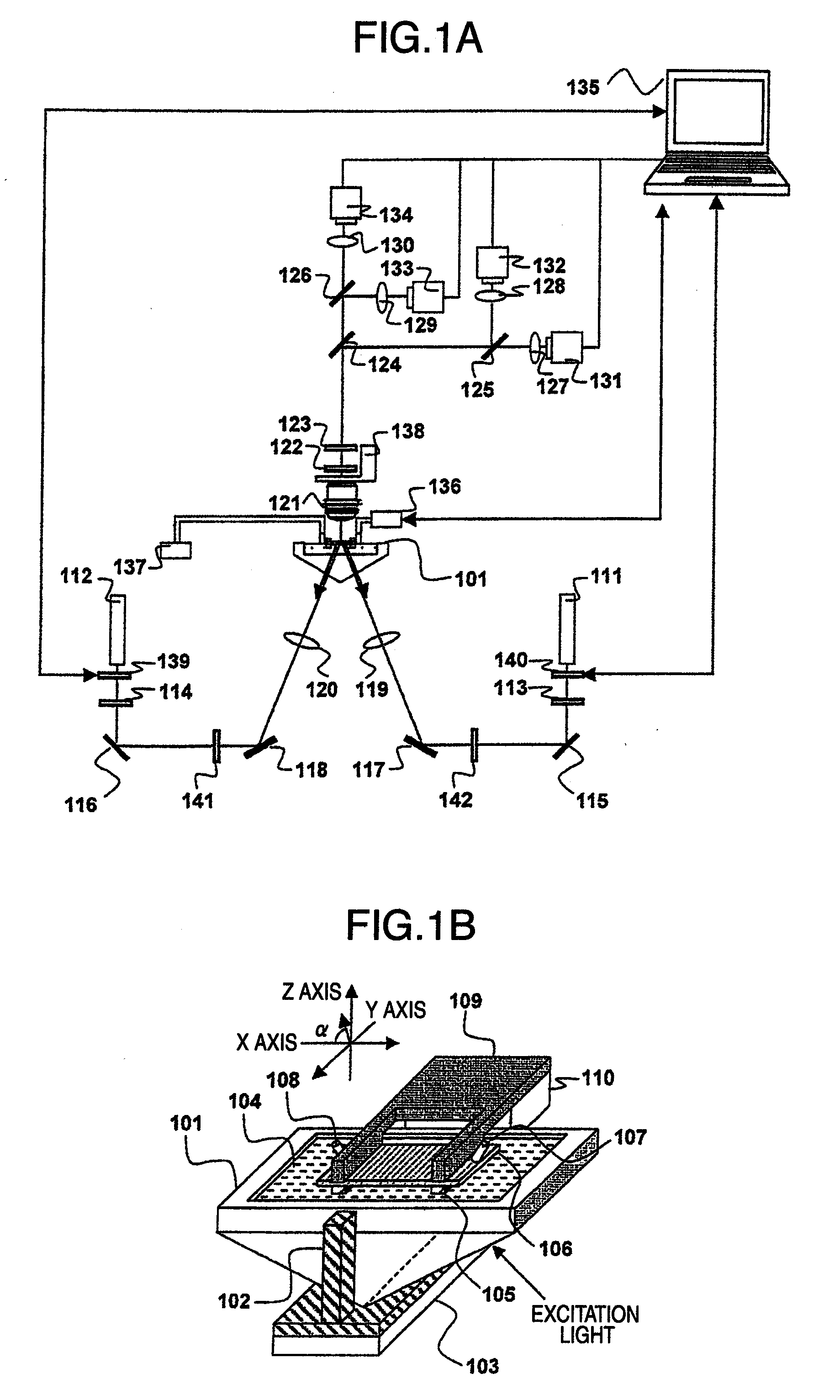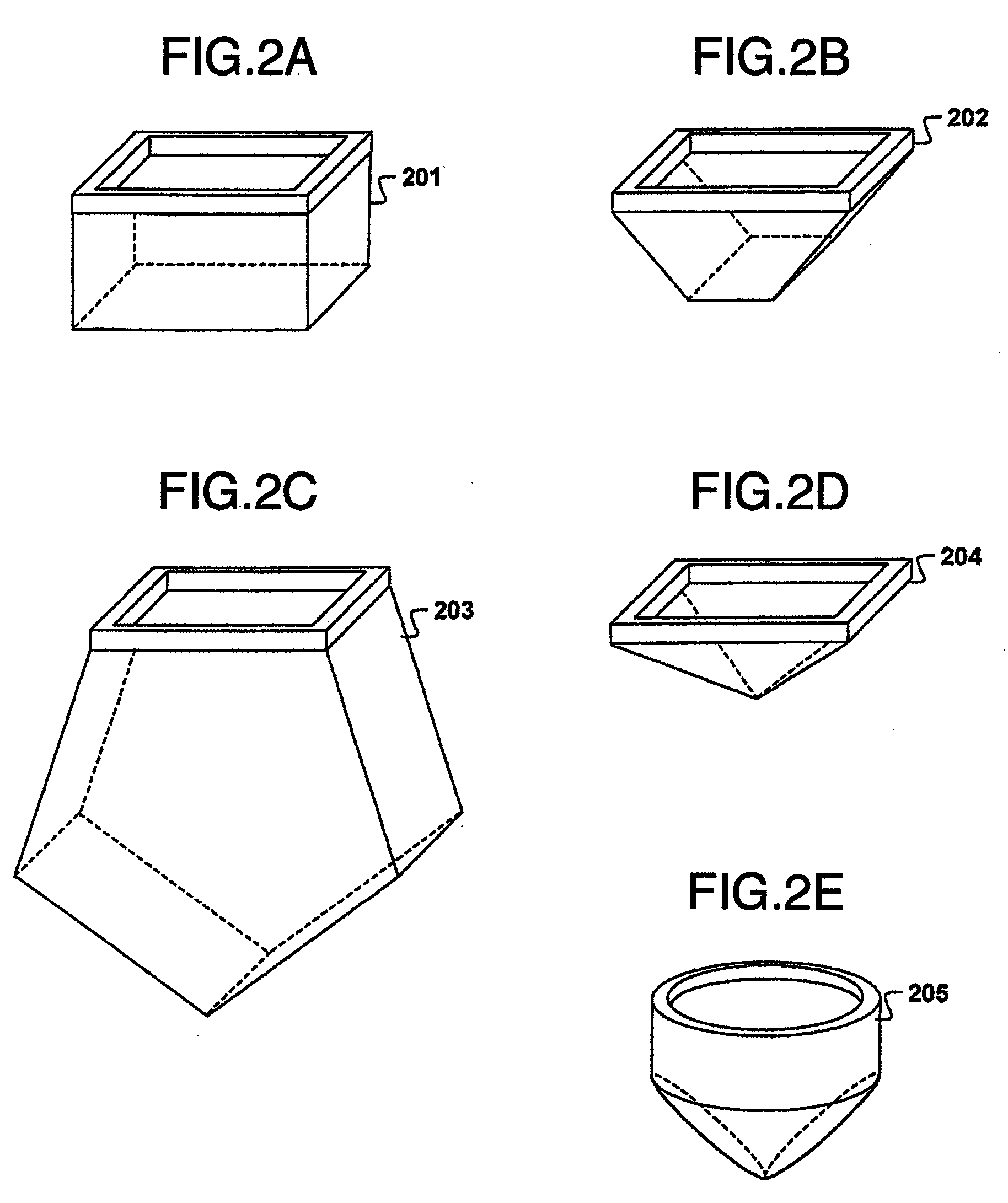Fluorescence detection apparatus
a fluorescence detection and apparatus technology, applied in the field of analysis techniques, can solve the problems of difficult movement of the sample substrate, inability to clean the apparatus, and inability to achieve the effect of improving the operation
- Summary
- Abstract
- Description
- Claims
- Application Information
AI Technical Summary
Benefits of technology
Problems solved by technology
Method used
Image
Examples
embodiment 1
[0039]FIG. 1A is a view illustrating a configuration of Embodiment 1 according to the invention. FIG. 1B is an enlarged perspective view showing a prism 101 and its vicinity.
[0040]A prism 101 provided with a well is, for example, made of S-BAL14 and has three 60° equilateral surfaces each having a size of 60 mm×50 mm. An acryl frame having height of about 8 mm (depth of the well later), as a wall of the well, is adhered to one (surface opposed to a sample substrate 106) of the three surfaces. Aside from the above-described method, a well structure may be prepared by cutting a surface of the prism 101.
[0041]Height of the well is required to be adjusted such that a surface of the sample substrate 106 including a sample supporting member 105 which opposes the prism 101, can be immersed in a matching liquid 104. Instead of S-BAL14, the material of the prism may be glass such Bak4, quartz or the like, resin such as PDMS or the like, or other materials as long as they have low absorptiven...
embodiment 2
[0068]Next, Embodiment 2 shows an example of measurement by a high aperture-oil immersion type objective lens.
[0069]A fluorescent signal from a single fluorescent molecule is weak. Thus, if a background is high or noise derived from an apparatus is large, it is difficult to detect emission bright spots. Therefore, detecting means having higher sensitivity, such as an objective lens with high numerical aperture, is required.
[0070]However, since an objective lens with numerical aperture of 1.3 or above is required to be used in an oil immersion state, there is a need to fill the immersion oil between a sample substrate and the objective lens. At that time, operability is poor, immersion oil flows around to make an apparatus dirty, or it takes a long time for a filling operation. Further, when the determination in Embodiment 1 is automated, an immersion oil filling device is required, thereby increasing the burden in terms of space and cost.
[0071]Embodiment 2 of the present invention p...
embodiment 3
[0076]In Embodiment 1, the excitation light sources 111 and 112 are provided in different light paths and the excitation light is incident from both sides of the prism 101, as shown in FIG. 1A. If a dichroic mirror 1602 is placed before a mirror 1601 and it is possible to make excitation light paths from two light sources 1603 and 1604 equal, as shown in FIG. 16, it is possible to reduce costs of optical components such as a condensing lens 1609, mirrors and so on and make an apparatus compact.
[0077]However, if the excitation light is incident from the same plane of a prism 1605 with the above equal light paths, deviation of a position of evanescent irradiation from light sources having different wavelengths increases due to a refraction angle difference at an interface between the prism 1605 and the matching liquid 1606 depending on a wavelength, along with a distance between the sample substrate 1607 and the prism 1605.
[0078]FIG. 17A illustrates respective light paths of when exci...
PUM
 Login to View More
Login to View More Abstract
Description
Claims
Application Information
 Login to View More
Login to View More - R&D
- Intellectual Property
- Life Sciences
- Materials
- Tech Scout
- Unparalleled Data Quality
- Higher Quality Content
- 60% Fewer Hallucinations
Browse by: Latest US Patents, China's latest patents, Technical Efficacy Thesaurus, Application Domain, Technology Topic, Popular Technical Reports.
© 2025 PatSnap. All rights reserved.Legal|Privacy policy|Modern Slavery Act Transparency Statement|Sitemap|About US| Contact US: help@patsnap.com



